The Cross in Nothingness
Hermann Bigelmayr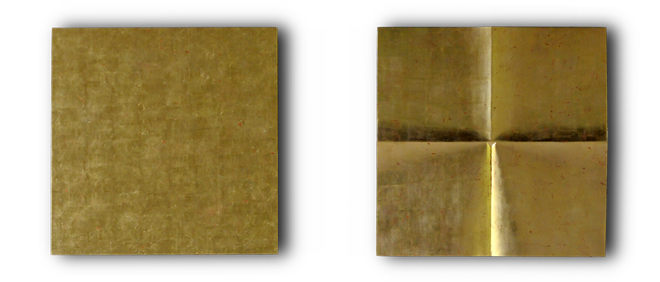
The interpretation of the signs and symbols that Hermann Bigelmayr has breathed into his work "The Cross in Nothingness" therefore challenges viewers to sharpen their vision and meditate on the image. In the favorable case, one is gifted by a new [through] look. A view that reminds us that ultimately - out of nothing - we discover in ourselves, the ingredients for inner peace, to be able to shape the outer peace in a renewed community of values hand in hand. Even when the hands are not yet outstretched in the other person.
Peter Michael Lupp
From the Limits to Growth to the Cross in Nothingness
Since 2011, an installation by the Munich sculptor Hermann Bigelmayr has been on display at the site under the guiding theme of "The Limits to Growth" (see per annum MMXI ff.). In terms of content, it is about the presence of an omnipresent mania for growth in our breathless society.
Against the backdrop that, in the same breath, the values of the Christian West, such as mercy and brotherhood, are increasingly being abandoned, the focus is shifting to how we might succeed in saving our moral integrity in a globalized world. This is the real cultural debate.
In this context, Hermann Bigelmayr was invited to conclude his five-year process work, which was supplemented and accompanied by a public discourse and artistic reflections at the cultural site Wintringer Chapel, by once again creating a pictorial sign. His artistic response is an installation entitled "The Cross in Nothingness", which resonates with the original work - an oversized stalk of wheat broken by unchecked growth in the vault of the chapel.
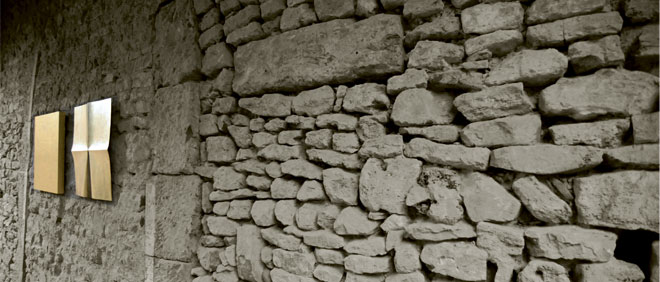
Across from the walled-up west portal of the sacred space, the installation reveals itself at first glance as two luminous golden squares, which, despite their restrained gestures, can become an essential carrier of meaning. In the search for sustainable ethical and spiritual values, the work invites interpretation and can certainly be read metaphorically.
About the origin of the image composition
The sculptor, who enjoys experimenting, also repeatedly follows the call of the church, which wants to showcase his creative power in the religious environment of sacred buildings. Seen in this light, he is no stranger to artistic interpretations of the cross as an original Christian symbol. The origin of a series of works entitled "The Cross in Nothingness" - each of which is site-specific - is based on the controversies that arose during a commission to design a cross installation for the new cemetery in Munich-Riem, which was designed in 2000 by the renowned architect Andreas Meck. There, while the design process was still underway, Bigelmayr was confronted with the task of expanding the classical interpretation of the cross for an artistic work on the cemetery grounds in such a way that the site could also be opened up to burials from other faiths.
After some deliberation, the artist used a higher level of understanding to resolve the clash of interests. In the outdoor area of the cemetery, a nine-meter-high sculpture was created from four mighty oak trunks arranged above a square. On top rests a mighty square stone that literally grounds the four poles from above, as if to hold together the manageable, earthly, human worlds of life. Only those who approach the work from within and look upward allow their eyes to focus on the sight. For some, the structure of a cross reveals itself, for others the symbol remains hidden - in nothingness.
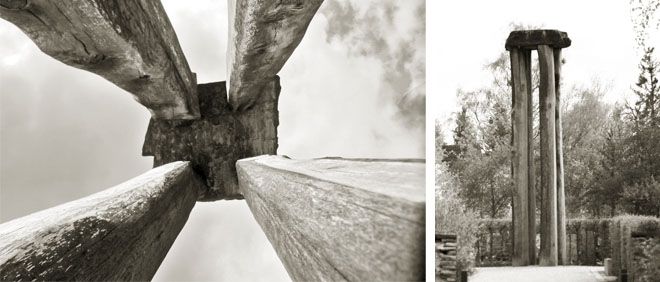
For the interior of the neighboring cemetery chapel, Bigelmayr made use of an equally simple but no less clarifying metaphor: the blank sheet. The double folding of a blank sheet of paper across the central axis haptically divides the sheet into four more squares. Only in the unfolding of the sheet do lines rise up, intersecting above the center point. A striking symbol now emerges haptically, which has been helping to express a religious world formula since pre-Christian times: a cross. If, in addition, paper with a high grammage is selected, a small triangle is created immediately next to the intersection point when the fold is opened. This extremely fine image of the connection of four opposite cardinal points, which seemingly arise out of nothing - or dissolve into it in the reverse thrust - the sculptor articulated in known fine handwriting in two square wooden reliefs to the cross in nothing.
Finally, the artist breathes the aura of the divinely supernatural and otherworldly into the work in the traditional manner with the finest leaves of pure gold, with which he has covered his wooden reliefs over dozens of carefully applied layers of chalk and helped them to shine.
With his artistic commentary on site, Hermann Bigelmayr created orientation symbols of an interreligious nature that allow for the most diverse perceptions without losing sight of the decisive cultural and religious imprint of the landscape in which the burial site is embedded. What has emerged is, so to speak, a matrix of basic ethical symbolism that is worth taking a long look at and analyzing.
So it's worth taking a closer look and exploring. Bigelmayr's iconic nothingness in the golden square in dialogue with a cross that seems to unfold can be read like a symbolism of an epoch from an analytical point of view. In a world out of joint, it marks acupuncture points for an ethical basis that transcends cultures.
It should not go unmentioned that the ingenious artistic answer to solving the conflict - The Cross in Nothingness - led to a controversial cultural-political debate in Upper Bavaria after its implementation on site.
www.hermannbigelmayr.de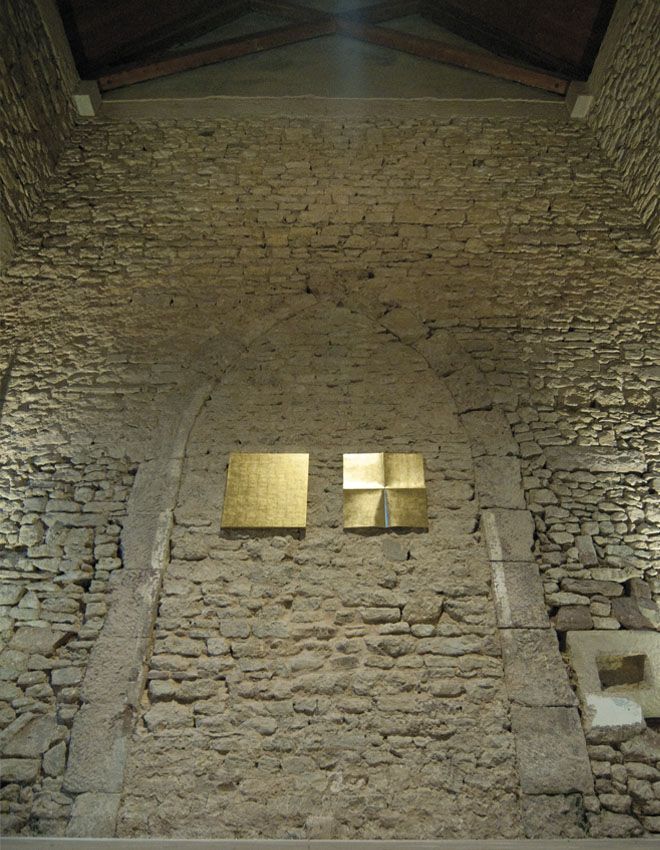
"The Cross in Nothingness" at the cultural site Wintringer Chapel
Hermann Bigelmayr's installation "The Limits to Growth" and the accompanying public discourse have been raising awareness of the continual transgression of the ecological limits of this planet since 2011 at the cultural site Wintringer Chapel. But where are the triggers for the fact that people ultimately destroy the foundations of their existence through unreflective growth thinking? How can the perceived realization be translated into action? Do the driving forces and the origins of the worldwide growth dictate lie possibly insolubly hidden in the deepest interior of humanity, there where values are formed and shaped?
In this patchy explanatory mosaic, points of reference to his previous works emerged for the artist at the cultural site Wintringer Chapel. A site-specific production of the two wall reliefs "The Cross in Nothingness", as an interpretive vehicle for an adequate confrontation, became the artistic strategy of choice.
Bigelmayr's "Cross in Nothing" thus offers a pictorial counterpart to the symbolism of traditional religious worldviews, without forgetting to hold up a mirror to us.
The two square reliefs therefore deliberately hang like icons in front of the bricked-up portal, which apparently does not want to allow any breakthrough. Immediately in front of it is a landscape dedicated to European togetherness in the Franco-German relationship within the framework of a Eurodistrict and, at the same time, promoting sustainable ways of life as a biosphere reserve. But not much further from the portals of Europe, wars and crises are shaking entire state systems and world religions. In many cases, the actual arsonists cannot be identified, but the source of the fire is blazing and dispersing. The view of the world structure is determined by never-ending streams of displaced people.
Questions about the extent to which religious beliefs are partly responsible for this are also pressing with unease in this country, since they sometimes also contain the glorification of violence. The symptoms of "disenchantment" throb incessantly louder, but why do the established cultures and their religions lack the world-reconciling substance?
Doesn't the mission of the UNESCO biosphere reserves in particular make it an overriding duty to intensively promote regional research on the ethical foundations of sustainable and peaceful coexistence between people and in harmony with nature? Are not the intercultural and interreligious concepts for a reconciling ethics in the first place in the peace project Europe?
These are the questions that come into focus through "The Cross in Nothingness" at the cultural site Wintringer Chapel. May the sighting trigger creative impulses in the viewers - towards self-responsible reflections, which personal ingredients can be contributed to a reconciling ethics. Some, however, would certainly prefer to kneel down in order to fade out.
Visual language - Of signs and symbols
The complex cultural history of the religious and ethical further development of mankind and their respective effects on inner and outer peace, on unification or divisiveness, on disintegration or future prove that morality and ethics cannot be decreed. Both are based, however, in the core on effect connections which were already recognized very early in the philosophical world views of mankind. These point to lifelike possibilities, how the human being can free itself by means of an imaginative consciousness from stuck thinking and a materialistic mindset.

Confucius already knew that neither words nor laws, but ultimately signs and symbols rule the world. It is recognized that their effect can be described as an independent form of non-verbal communication, which is also capable of directly triggering a dialogue with the subconscious. Symbols and their culturally founded categories of meaning send an impulse to the unconscious and stimulate the formation of will.
These aspects can be clarified by means of the visual language of Hermann Bigelmayr's work. The symbolic power of the signs he chooses have such a strong effect that he limits himself to a fundamentally reducing expressive format for his sculptural work. In this way, the individual themes are conveyed like superimposed layers whose respective meanings can be interwoven to form a field of action. For the viewer, comprehensible philosophical "research themes" open up in the conscious dialogue between pictorial language and symptomatology, the results of which - however inconspicuous - can be applied to the realities of life.
The following "reading guide" offers a possibility to open the work in its depth layers upon closer examination, in order to expand the repertoires of thought and action of the viewers via this art didactic approach. A first isolated consideration of the meaning of the individual symbols in the context of the place and its questions facilitates this process.
The cross
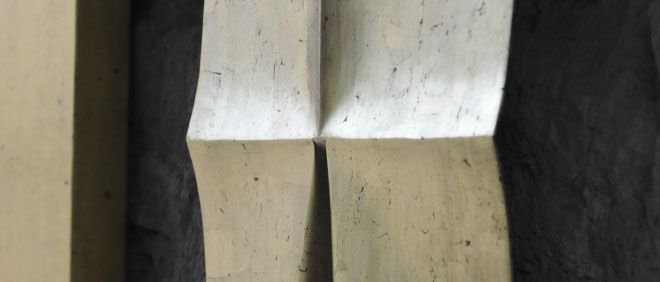
Like intersecting timelines, in the artist's previously described approach, the contours on the right square unfold into a relief of the cross, almost as if the cross of Christianity (which did not officially establish itself as a Christian sign until 431 A.D.) had once again returned to the world of the medieval priory church in Wintringen with its ideas of apocalypse, expulsion from paradise, the Last Judgment, and spirals of hope for the salvation of souls.
However, Hermann Bigelmayr is obviously also interested in ensuring an interpretation of the cross in other cultural contexts in order to enable extended conclusions for the viewer. The vertical line, for example, is associated with the upright walk of man and thus with sincerity or straightness. This also explains the interpretation as a spine, world axis or the tree of life.
In contrast, the horizontal represents the beginning and the end and thus the path of knowledge from birth to death. However, knowledge will only be gained on this line by those who actively strive for the reconciliation of opposites, mediating between the polarities, for example, good and evil, male and female. Already in the symbolic language of the pre-Christian times the cross is read in connection of the spheres: the horizontal line stands for the earthly and in the vertical line for the path from the earthly to the heavenly. But only the connection of the lines over the center causes the meeting and the synergetic connection of the two spheres heaven and earth. The symmetrical intersection of the lines to form the cross divides a surface, like Bigelmayr's blank page, into four segments of equal size, indicating both the four elements and the bond between spirit and matter in man.
The dividing lines also align with the four cardinal directions. In connection with a circle, the course of the sun through the four seasons and ultimately also the holistic can be read out of this symbolism.
Literature: Sebastian Anneser, Friedrich Fahr, Peter Steiner: Kreuze und Kruzifix - Zeichen und Bild
Essence: In the upright walk, the gaze is directed to the reconciliation of opposites. To pass away in order to become.
The triangle
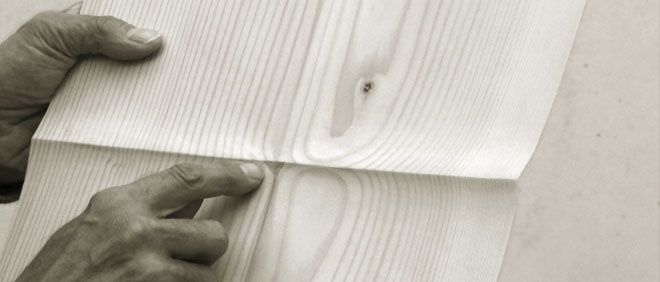
At the intersection of the cross lines, as already described, a small triangle is created - a profound meditative symbol - which the artist strikingly emphasizes.
As a carrier of meaning, the isosceles triangle permits the most diverse interpretations. In Christian art it is defined as the all-perceiving eye of God, likewise as a symbol for the Trinity of God the Father, Jesus Christ and the Holy Spirit. The downward triangle is also one of the oldest symbols describing the feminine in humanity, which sometimes implies goodness, compassion, caring. In anthroposophical philosophy, symbols circumscribe realities that can be experienced as an existing dimension in the creation of the world. With a triangle as a symbolic form, for example, a reality is described that is also present in the spiritual creation; it reminds the soul of the trinity of the spiritual worlds: Soul Life, Matter, Spirit. The isosceles triangle implies here an existential requirement that life addresses to being human: the balance and the equilibrium.
Literature: Dictionary of Christian Iconography, Rome 1994
Essence: Only in an equilateral, appreciative, tolerant interplay is an alignment of individual existence and the superordinate world structure possible that unites the cultures.
The nothingness
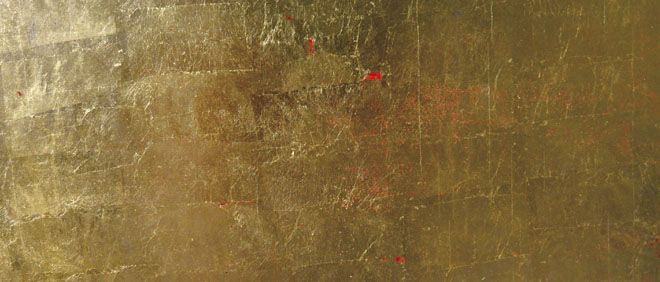
Opposite in the left square relief the nothingness appears in front of the walled west portal. The square obviously shows no traces of artistic treatment, with the exception of the gold leaf with which the untreated wooden square was covered. Bigelmayr consciously places the absence of artistic influence, the indeterminate emptiness on the square as a counterpart to the sculpturally breathed symbolic power of his cross relief and thus emphasizes the interaction. The apparent absence of artistic treatment becomes the expressive format of an existential experience with nothingness, without the precondition of which a new thinking in the sense of creative (co-)action in the world circle of the blue planet is not possible. In the French language there is the word "néant" for this. That what is not, but can be.
In this possibility of a spiritual "reset" into nothingness to the inevitable emptiness as conditio for the salutary new, the philosophical interpretations of the late antiquity and the early Middle Ages shimmer through. According to Augustin the emergence of the creation can have taken its course only under the condition of a previous nothing, everything else would be in the reverse conclusion no creation but constant transformation. In the history of philosophy the illumination of the possibility of nothingness takes a central role across the times.
In a different context, the nothingness cited by Bigelmayr on the wall can also be read, for example, about the teachings of Hegel and Bloch. Hegel places nothingness on the same level with being and allows both to merge into each other in order to establish the process of becoming. According to Bloch, man experiences a lack in nothingness, which he intuitively tries to abolish. In this, Bloch recognizes a basic constant in the nature of mankind, a striving for overcoming, ultimately the principle of hope.
Essence: Conscious being, understanding as transformation and becoming unfold through voids in the mind (meditation into nothingness).
The gold
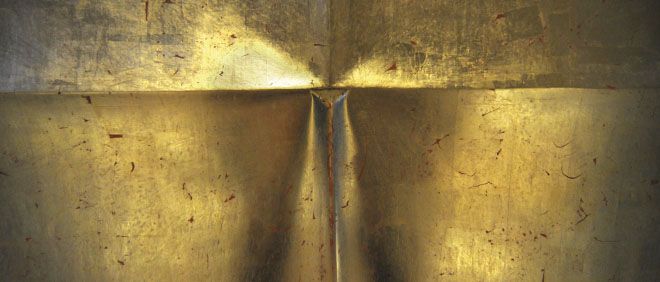
In all world religions, gold stands for the divine, the brightness of life, the valuable and value-giving basic religious principle, which remains the divine - the higher power - despite all the influence of mankind. Gold is associated with purity, wisdom, the sacred par excellence. In the alchemy of the Middle Ages, gold stood for solidified light, for the attainment of the center, the balance between the poles. In anthroposophic medicine it was used as Aurum metallicum to stabilize the structure of the elements, in cases of exhaustion and metabolic weakness.
Hermann Bigelmayr seems to be concerned with this stabilization of the structure in human existence and coexistence between man and nature, and he consequently prescribes gold in homeopathic gold leaf doses over proverbial multi-layered artistic commentary.
With the final gilding of the two reliefs, however, the interrelationship between ethics and human nature is ultimately put on the gold scale and gives an idea of one of the reasons why it just won't come into balance. Human coexistence suffers in the present from a serious disease, which in many cases has not even been diagnosed yet - indifference. This is due to a lack of empathy. To rebel against it is a highly personal act, not an aggressive one, a self-determined and not externally determined one, and delivers with every ounce more a step towards the balance necessary for survival on this earth.
Essence: The sacred arises in empathy, which seeks the balance between polarities.
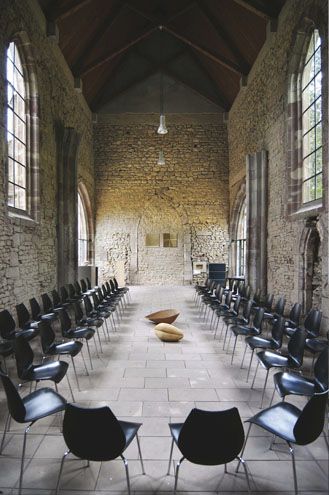
Epilog
The interpretation of the signs and symbols that Hermann Bigelmayr has breathed into his work "The Cross in Nothingness" therefore challenges viewers to sharpen their vision and meditate on the image. In the favorable case, one is gifted by a new [through] look. A view that reminds us that ultimately - out of nothing - we discover in ourselves, the ingredients for inner peace, to be able to shape the outer peace in a renewed community of values hand in hand. Even when the hands are not yet outstretched in the other person.
A willingness to join hands and likewise to deal with the signs of our times in order to actively shape our life worlds with a poetry of the heart instead of ducking away would be a good overture to learn. Works like "The Cross in Nothingness" can help with this.
After all, they are able to recognize the building blocks of a reconciling ethic - let's call it "The Divine Behind Nothingness" - and scatter them like seeds on a fallow field.
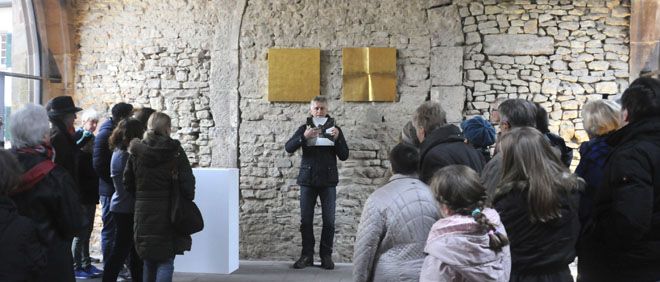
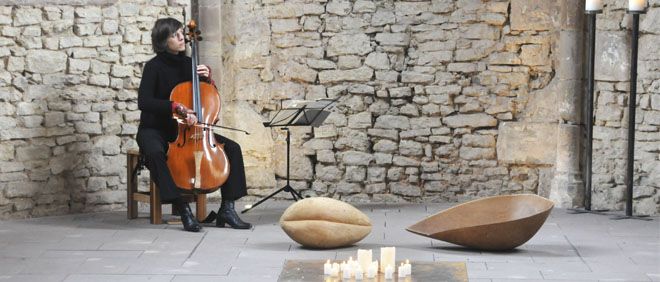
Impressions of the opening event for the theme year: Marie Colombat reflected the visual language musically on the cello.
